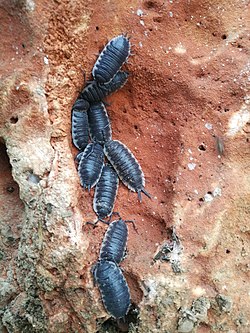Biology:Porcellio hoffmannseggii
| Porcellio hoffmannseggii | |
|---|---|

| |
| Scientific classification | |
| Domain: | Eukaryota |
| Kingdom: | Animalia |
| Phylum: | Arthropoda |
| Class: | Malacostraca |
| Superorder: | Peracarida |
| Order: | Isopoda |
| Suborder: | Oniscidea |
| Family: | Porcellionidae |
| Genus: | Porcellio |
| Species: | P. hoffmannseggii
|
| Binomial name | |
| Porcellio hoffmannseggii Brandt, 1833
| |
Porcellio hoffmannseggii, commonly called the titan isopod, is a species of woodlouse of the genus Porcellio described in 1833. This very large species is native to the southern Iberian Peninsula, Morocco and the Balearic Islands.[1]
Porcellio hoffmannseggii should not be confused with Platyarthrus hoffmannseggii, which is also a woodlouse, from the genus Platyarthrus.[2] These two species share the same abbreviated binomial name of P. hoffmannseggii, which is a potential source of confusion. Porcellio hoffmannseggii may be listed with incorrect spelling as Porcellio hoffmannseggi, missing the final 'i'.
Appearance and physical characteristics
Porcellio hoffmannseggii is considered to be one of the largest terrestrial isopod species, with adults able to grow to be over 1.5 inches (3.8 cm) long. They are typically dark grey or black, with a thin white skirt around the edge of their body. Males of this species have longer uropods than females.
Porcellio hoffmannseggii is a species with multiple identified subspecies. There are current 4 identified subspecies, which are as follows:[3]
| Trinomial designation | Classification author and date | Notes on subspecies |
|---|---|---|
| Porcellio hoffmannseggii hoffmannseggii | Brandt, 1833 | |
| Porcellio hoffmannseggii nemethi | Paulian de Felice, 1941 | |
| Porcellio hoffmannseggii sordidus | Budde-Lund, 1885 | Considered to be a subspecies that inhabits the western Balearic Islands.[4] |
| Porcellio hoffmannseggii tamarisis | Verhoeff, 1937 |
Behavior and reproduction
Porcellio hoffmannseggii does not conglobate like some of their other isopod cousins, commonly called pillbugs. It has been observed to guard their young after birth. The species is known to be very territorial for an isopod, which makes captive culturing more difficult.[5]
Distribution and habitat
Porcellio hoffmannseggii is common in the Oued Laou region of north-eastern Morocco, when compared to the distribution of other isopod species in the country.[6] In addition to southern Spain and northern Morocco, this species is also native to Portugal.[7]
Compared to other Porcellio species, this species has been observed to prefer drier environments while kept in captivity.[5]
References
- ↑ Schmalfuss, H. (1987-12-15). Revisión der Gattung Porcellio (Isopoda, Oniscidea). 1. Beitrag: P. Hoffmannseggi und P. magnificus. https://digital.csic.es/handle/10261/171968.
- ↑ Bakhshi, Yaser; Sadeghi, Saber (2019-09-10). "First record of the ant woodlouse, Platyarthrus hoffmannseggii Brandt, 1833 (Isopoda, Oniscidea, Platyarthridae) from Iran". Crustaceana 92 (8): 1021–1024. doi:10.1163/15685403-00003926. ISSN 0011-216X. http://dx.doi.org/10.1163/15685403-00003926.
- ↑ "ITIS - Report: Porcellio hoffmannseggi". https://www.itis.gov/servlet/SingleRpt/SingleRpt?search_topic=TSN&search_value=596382#null.
- ↑ Schmalfuss, H. (1987-12-15). Revisión der Gattung Porcellio (Isopoda, Oniscidea). 1. Beitrag: P. Hoffmannseggi und P. magnificus. https://digital.csic.es/handle/10261/171968.
- ↑ 5.0 5.1 Dan (2022-11-07). "How to care for Porcellio hoffmannseggi (The Titan Isopod)" (in en-GB). https://terrariumtribe.com/porcellio-hoffmannseggi/.
- ↑ "The diversity of terrestrial Isopoda in the Berkoukech area, Kroumirie, Tunisia". Crustaceana 81 (8): 917–929. 2008. doi:10.1163/156854008x354948. ISSN 0011-216X. http://dx.doi.org/10.1163/156854008x354948.
- ↑ Schmalfuss, H. (1987-12-15). Revisión der Gattung Porcellio (Isopoda, Oniscidea). 1. Beitrag: P. Hoffmannseggi und P. magnificus. https://digital.csic.es/handle/10261/171968.
Wikidata ☰ Q2043619 entry
 |

